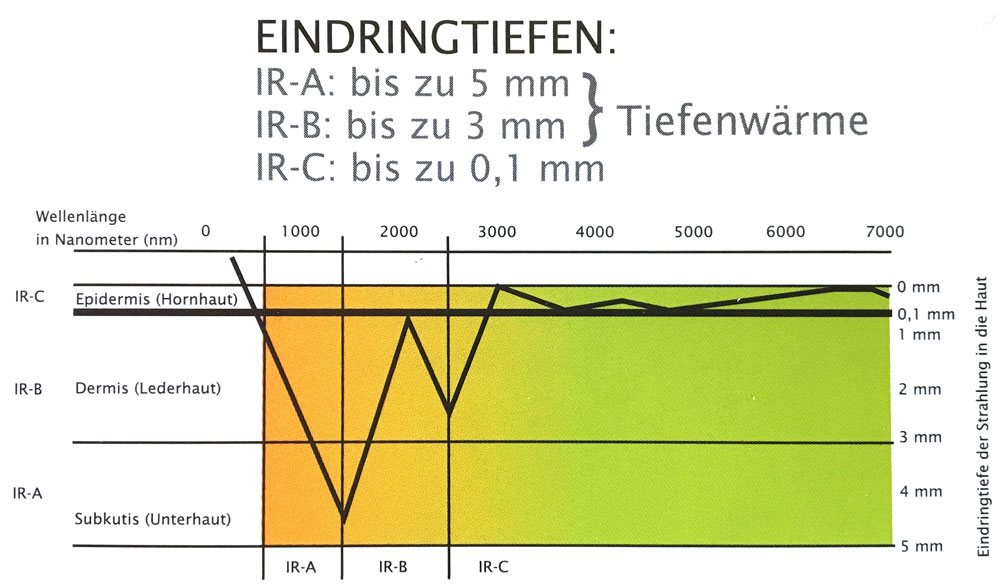Click here to visit our BLOG - Insights & tips on infrared cabins and saunas, DIY projects, and more...
Blog articles on infrared cabins & their applications, tips for usage and DIY building, sauna upgrades, and more…
Knowledge of infrared radiation
Infrared radiation is a natural component of sunlight. Without this radiation, which we perceive as warmth, there would be no life on earth. The atmosphere filters out a large portion of infrared radiation, specifically IR-C.
Thus, in nature, we enjoy the natural infrared-A and infrared-B radiation of the sun. Our special InfrarROTmed heaters are modeled after natural sunlight.
What is deep heat?
Scientists refer to infrared A and infrared B radiation as deep heat, which can penetrate up to 5mm into the tissue, where it is then absorbed. As a result, the tissue can be warmed up very quickly and gently and better supplied with blood, which means that the muscles are better supplied with oxygen and nutrients.
Even at low temperatures, the deep heat effectively warms our body and stimulates our self-healing powers. Especially the infrared A radiation has already been shown to have many positive effects.
Muscle tension can be released and back pain relieved. The sweating process, which is gentle on the circulation, purifies and detoxifies the body.
The associated increase in body temperature (“artificial fever”) activates the self-healing powers and strengthens the immune system.
With infrared-C radiation, however, the heat transport only works indirectly via heat conduction, since it can only penetrate a maximum of 0.1 mm into the skin.
Red light has been used for over 120 years.
Relieving
Muscle Tension
Detoxification &
Purification
Improvement of
Circulation
Strengthening of
the Immune System
Stimulation of the metabolism
Cardiovascular endurance training
Deep warming radiation
With the effect of the infrared radiation of the fire as a model, our emitters donate deep heat.
The infrared radiation

infrared-A
The depth of penetration into the skin and into the eye is greatest in the IR-A range, with the radiation energy being absorbed over a relatively large volume. The ARC Seibersdorf research GmbH confirms that full-spectrum heaters do not harm the eyes when used normally.
The irradiation intensity of IR-A heaters is far below the ICNIRP limit, making thermal damage to the retina impossible, even with prolonged staring into the source.
infrared-B
As a result of the increased absorption by water, the depth of penetration of this radiation decreases drastically with increasing wavelength and reaches a minimum at a wavelength of 3,000 nanometers.
infrared-C
The penetration depth remains far below 1mm over the entire area due to the very strong water absorption, i.e. the radiation energy is absorbed directly on the surface of the eyes and skin. The term “deep heat”, which is often used for long-wave radiators (IR-C radiators), is therefore incomprehensible from a biophysical point of view.
InfraROTmed-heater
Our full spectrum heater
Current types of radiators used in infrared cabins
IR-C – Large-area long-wave radiators (panels)
Practically the entire wall becomes warm here, whereby the surface temperature is usually only approx. 50 ° C. The emitted radiation is therefore in the far IR range (i.e., entirely within the IR-C spectrum).
Note: Surface heaters, heating systems, saunas, tiled stoves, hot water bottles, bathtubs.
IR-B/C – Long wave radiator
Have a surface temperature of approx. 300 to 380 ° C and are often designed as rod radiators. At this temperature there is no longer absolutely pure IR-C radiation. About 5 to 10% of the radiation power is in the IR-B range.
IR-A/B/C – Shortwave radiators
With glowing tungsten filaments surrounded by glass or quartz tubes, radiator temperatures of up to 2,000 ° C can be achieved. The principle here is similar to a filtered halogen bulb and is known in smaller designs as a red-light bulb, which has long been used in households as a heat lamp (especially for head irradiation).
The radiation distribution is again determined by the temperature of the emitter – the peak of the spectrum lies, depending on the temperature, in the IR-A range or at the boundary between the IR-A and IR-B ranges.
Note: Conventional full-spectrum emitter.
InfraROTmed – IR-A/B/C – shortwave heaters
- Protected InfraROTmed radiator for red light and infrared light applications.
- Linear double filter for a higher proportion of red light
- Adaptively adjustable infrared range (in connection with icon control)
- Surface heater (hot water bottle, radiator) 0%
- Ceramic, incoloy / magnesium oxide emitters 10%
- Full spectrum radiator – opaque 70%
- Full spectrum radiator – clear 80%
- InfraROTmed fullspectrum heater 90%
- sun 100%
Source: “Information Sheet on Infrared Heat Cabins,” Department of Laser and Optical Radiation, v1.2 April 2006 © ARC Seibersdorf Research GmbH 2006
Images:
Shutterstock/Stasique
Gurtner Wellness

